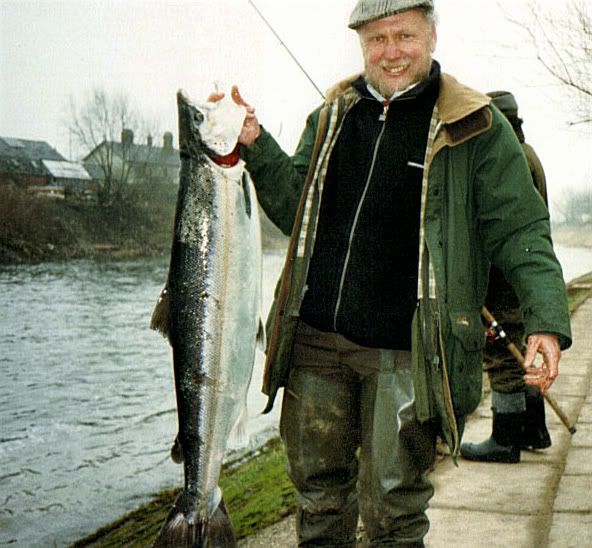February started with a fish of 21lb caught at Atcham on opening day. Leighton produced an early fish of 20lb and Cressage one of 15lb. However, the river turned high and coloured for most of the month bringing fishing to a standstill. As levels started to drop back, the first beat to score was the lock bank at Diglis on the 20th (a well known high water beat) and this was followed up by a fish from Lincomb weir below Stourport.
Salmon fishing got going properly in March with Diglis the prime fishery. The best from the beat was a fish 26lb, caught by Paul ‘the cormorant’ who also had another fish on the same day. A run of very big fish was seen going over the weir at end of the month as water levels rose yet again.

A big Severn springer for the comorant
Atcham produced three to 19lb, and Wroxeter two. Royal Hill and Cressage had one each.
The fishing in April was outstanding. Graham Hadley, summed up the mood on the bank: ‘I reckon we have had the best April for many years... It is strange how nature has a way of correcting her losses – who would have thought that, only a season ago, talk revolved around the ending of the Severn as a worthwhile salmon fishery. I was among many who lamented her fall from grace. ‘
The lowest beats on the semi-tidal section had twenty fish for the month. But, Diglis was once again the most productive cast. Graham Hadley, enthused about the venue, which he described as ‘the jewel in the crown of the Severn spring beats ‘.
According to Mr Hadley: ‘The ‘golden beat’ as one aged rod once called it, was certainly golden during late March and April, as run after run entered its lies and delivered a wholesome harvest of springers wrapped in sea lice.’ The best two salmon from the fishery for the month weighed 22lb each.
The river came up again in mid-month, the rising waters induced some fish to move upstream with Bridgnorth to Cressage producing four fish, Wroxeter to Atcham six to 22lb, while the ‘usually dour’ Shrewsbury weir added another two.
However, it was also reported that the fish were a ‘little reluctant’ to run above Shrewsbury. Despite a lot of rods out in response to news of catches down-river, just seven fish were reported from the upper Severn and Vyrnwy.
The good running conditions also helped the fishing on the Teme with seven fish reported.
The next monthly report continued in up-beat form: ‘the record salmon runs of April continued throughout May’. High water at the end of April had again brought fishing to a standstill: it was during this period that what was described as a ‘real cracker of a run’ took off.
Catches were reported throughout the system. There was a ‘real bonanza’ at Diglis. Beats around Cressage accounted for nine fish to 21lb, Criggion produced six, and Newtown four. Fresh silver fish were seen as high upstream as Llandinam.
Traditional low water beats did exceptionally well in June as levels dropped. Fourteen were reported from Bridgnorth to Cressage, the biggest 22lb, ten around Atcham and the same from Shrewsbury weir to Underdale. Beats up to Newtown accounted for nine with the best a 21lber. The Teme did well, though no figures were supplied and a scattering were reported from the lower Vyrnwy and ten from the middle reaches.
July was described as a mixed month due to a low and warm river. The lower river beats picked up the odd fish and eight were banked between Llandrino and Welshpool including a bright 19lber.
August again saw very low river levels, but fresh fish were still being caught in the lower beats. However, there were worries about the lack of grilse. There was also concern over fish deaths in the estuary and tidal river due to depleted oxygen and pollution. The T&S report mentioned a major fish kill ‘a few years ago’ when ‘almost 40% of the catch was lost’, but no more details were given.
September saw continued low water levels and the ‘record runs of spring’ had now become just a ‘distant memory’ as an atmosphere of doom and gloom pervaded the reports. A handful of bright fish were reported from the lower river.
October saw the season end with a bit of water and a few fish.
Discussion
The bulk of the catch came before the end of May. Rod effort was concentrated in the spring in this period and was probably something like 10 times greater than it has been in the same months in recent years. Many of the pre-June fish from up-river were caught on the worm, a method that is outlawed today.
Statistics
rod catch monthly
Feb Mar Apr May Jun Jul Aug Sep Oct
10 39 73 213 134 39 27 34 15
Rod effort
13,056 rod days
Catch-per-unit-effort
3.19 salmon per 100 rod days
2006: 6.6 salmon per 100 rod days
No comments:
Post a Comment
Note: only a member of this blog may post a comment.